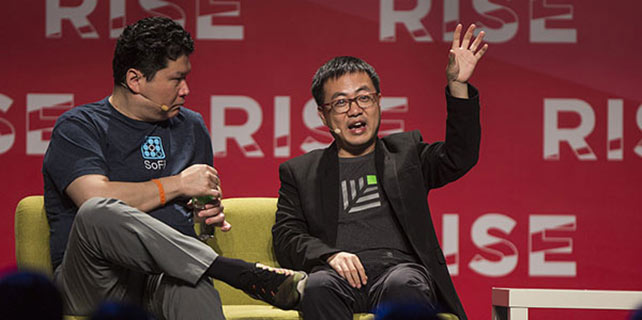Linking up the world and here's HK
The country's economic miracle has been a godsend to HK, says JPMorgan Chase executive Jing Ulrich. She tells Duan Ting the SAR's role in two of the nation's most ambitious projects is a blessing that's hard to ignore.
Talking to Jing Ulrich - ranked as one of the world's foremost financial power brokers and strategists - her vision for a super strong economic Asia and China, in particular, stands out as magnanimous, down to earth and convincing.
In her philosophy, Asia, led by the Chinese mainland, is dead set to drive the world in future growth - a force that has consistently been presented as the most credible threat to the traditional economic supremacy of the United States.
In a wide-ranging interview with China Daily, the Beijing-born and raised Ulrich took up the cudgels for two of the mainland's most ambitious projects to date - the expansive Belt and Road Initiative and the Guangdong-Hong Kong-Macao Greater Bay Area - in tones that few, or none, worldwide can hold a candle to in terms of economic magnitude and connectivity.
Hong Kong's part in these initiatives, she says, is intrinsic and dominant, leveraging its global financial center status in raising capital for the Belt and Road and the Greater Bay Area.
The flamboyant executive, who's managing director overseeing Asia Pacific operations at US-based banking and financial services colossus JPMorgan Chase, took pains to stress the city's role as the gateway to the Chinese mainland and the Belt and Road countries, added up by the pivotal location of mega infrastructure projects in the Greater Bay, notably the Guangzhou-Shenzhen-Hong Kong Express Rail Link and the Hong Kong-Macao-Zhuhai Bridge.
These projects are badly in need of funding, and Hong Kong can wrap it up by coming up with additional capital for infrastructure investment, showing how companies can invest in the Belt and Road projects and manage risks, as its sound legal system offers a natural platform for governance and arbitration.
Hong Kong can also export its know-how to the Belt and Road countries and regions in terms of project management, accounting and legal compliance, using Hong Kong enterprises' infrastructure expertise.
Ulrich, who has a penchant for organizing high-profile China investment gatherings to get outsiders adequately acquainted with the mainland's business climate, nails the perception that Hong Kong is still way behind its regional rivals in innovation, arguing that the SAR is "just steps away" from Shenzhen and, as far as helping startups to get off the ground is concerned, Hong Kong's vibrant banking center and lots of wealth in solving investment targets are something that cannot be shrugged off.
Economic hub
The Belt and Road Initiative - a long-term project proposed by President Xi Jinping in 2013 - is designed to focus on connectivity and cooperation and drive bigger and faster trade and capital flows between East and West. It covers two trade routes and an overland route connecting Europe, Middle East and China, linking up with 65 countries in Europe, Asia and Africa that represent 63 percent of the world's population and 29 percent of global GDP. The overall objective of the Belt and Road, notes Ulrich, is to boost regional trade, enhance regional infrastructure and encourage economic cooperation.
The Greater Bay area embraces Hong Kong, Macao and nine key cities in Guangdong province - Guangzhou, Shenzhen, Zhuhai, Foshan, Zhongshan, Dongguan, Huizhou, Jiangmen and Zhaoqing - with the aim of turning it into an integrated economic and business hub rivaling some of the world's famous bay regions. The combined GDP of China's bay area is estimated at $1.4 trillion, with a population of 66.7 million.
The Guangdong-Hong Kong-Macao Greater Bay area is part of the nation's plan to promote urbanization by developing city clusters and leveraging the strength of first-tier cities to boost growth in the less developed ones. Ulrich says the region provides a gateway to overseas markets, and companies there can rely on Hong Kong's rich experience in interacting with foreign markets and capitalize on the SAR's financial setup in raising funds and attracting international capital.
"It's also a good bet for innovation and high-tech industries. Internet giant Tencent, the third-largest smartphone maker Huawei, and global market beater in drones DJI are all based in Shenzhen, which has been attracting highly-skilled technology, robotics and engineering professionals from all over the world. The bay area will see great improvement in infrastructure which will generate opportunities."
Challenges ahead
However, Ulrich warns investors to expect challenges as some of the countries along the Belt and Road may be politically unstable, coupled with an incomplete and unsophisticated legal regulatory framework which would impede foreign investment.
For the bay area, she explains, Hong Kong, Macao and the mainland have different regulatory, economic and environmental policies, adding that, in some cases, the central government may have to step in to coordinate among various cities to reduce unnecessary competition and clarify regulatory differences.
And, how to evolve from an advanced manufacturing center into an innovation and R&D (research and development) hub is another challenge. "To do so, a business-friendly policy environment and providing space for entrepreneurial activities would be the key," she says.
Ulrich stresses that each of the cities in China's bay area has a unique place - Hong Kong is the global hub of finance, Macao is the top tourist destination and a notable offshore financial center even though smaller than Hong Kong, Shenzhen is China's first special economic zone and is host to some of the nation's most valued technologies, while Guangzhou continues to be a globally significant manufacturing and trading hub. All these are backed by a huge population, well-established infrastructure, and a strong and highly skilled labor force.
As to how Hong Kong could still improve its role, Ulrich cites its big pool of major listed enterprises and its reputation of helping small companies to grow big, which attract more technology-oriented firms and entrepreneurs to establish a presence in the city. Two investment funds launched by the government for technology and startups is a good way to kickstart the process.
On the other hand, Hong Kong needs to throw in more incentives to encourage multinational companies to set up R&D centers in the city. Many of these multinational companies had picked Singapore or Shanghai to establish their R&D centers as Hong Kong's soaring housing costs and lack of education facilities for expatriates' children are drawbacks.
"I think the government can offer more tax cuts, subsidized office space, and better school access to attract overseas technology talents and lure top Hong Kong graduates from overseas universities," she says.
She also urges the Hong Kong government to increase its support for universities to conduct research with relevant commercial applications, saying Hong Kong has lots of wealth and big business groups that could give a lift for local universities. Upgrading the local primary and secondary education systems can help enlarge the future talent pool. "If you think of science and technology as an ecosystem, a lot of talents are nurtured from the very early stage."
Contact the writer at tingduan@chinadailyhk.com









